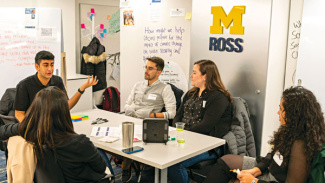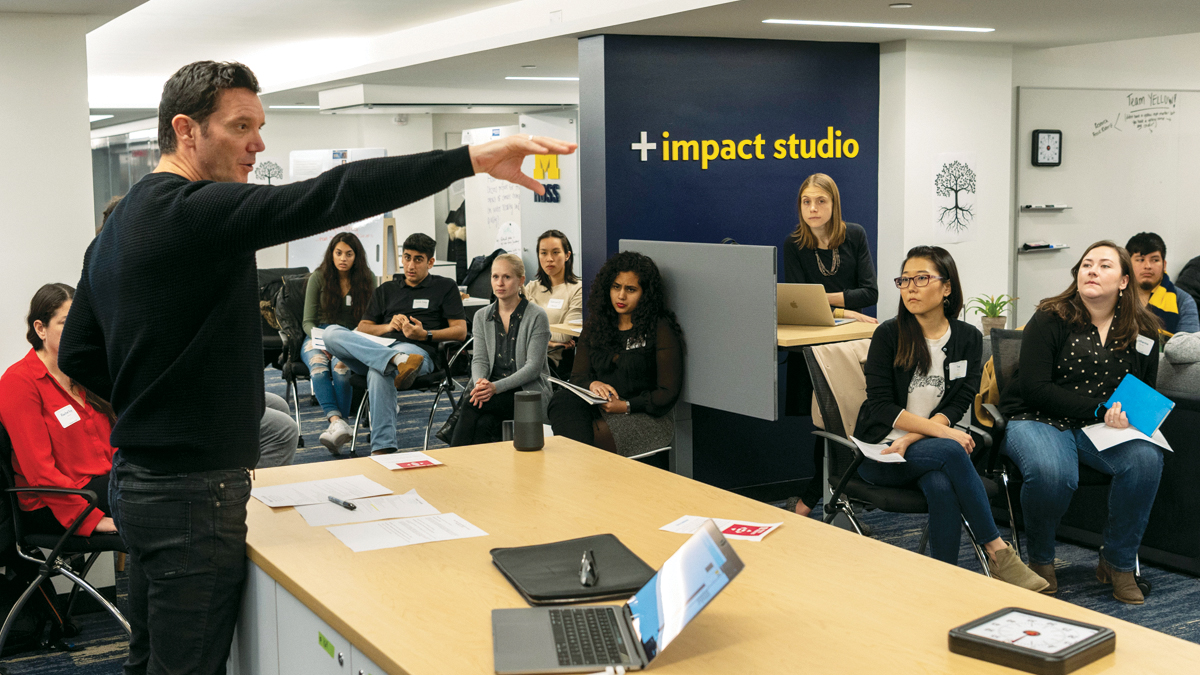Students Use Faculty Research To Develop Real-World Applications For Reducing Inequality At The +Impact Studio at Ross

Around 30 students from six schools across the University of Michigan gathered in the +Impact Studio at the Ross School of Business on Nov. 21, to take insights from Michigan Ross faculty and create ideas on how to reduce inequalities around the world. The event was the second workshop in Business+Impact's new Faculty Research for Impact (FR4I) series this year.
Each workshop in the series takes on a different UN Sustainable Development Goal (SDG) and features a panel of faculty experts who present their related research to students. Then, the students participate in a design activity to develop ideas for real-world applications of the research directly addressing the goal.
 “The purpose of these events is to take a very high-level impact issue like a UN SDG, view it through the lens of relevant scholarly research, and then have the students distill and articulate specific avenues we could pursue,” said Jeffrey Sanchez-Burks, faculty director of the +Impact Studio course, who led the FR4I workshop.
“The purpose of these events is to take a very high-level impact issue like a UN SDG, view it through the lens of relevant scholarly research, and then have the students distill and articulate specific avenues we could pursue,” said Jeffrey Sanchez-Burks, faculty director of the +Impact Studio course, who led the FR4I workshop.
For this event, Jun Li, associate professor of technology and operations, shared her research into discrimination in the sharing economy; Yesim Orhum, associate professor of marketing, shared her research into how liquidity constraints impact low-income households’ ability to take advantage of price promotions; and Chris Rider, associate professor of strategy, shared his research into racial disparity in promotion rates for NFL coaches and, specifically, the effectiveness of the Rooney Rule (a highly replicated rule that requires at least one member of a racial minority group to be interviewed for each open head coach position).
Following the research presentations, students were divided into small groups, with each one using a specific faculty member’s research for the design activity.
The students’ first assignment was to generate as many ways as possible to think about the problem of reducing inequality. The goal was to discover different ways the problem could be understood, and then to identify the most viable and impactful idea. Teams took the idea and converted it into a “How Might We” opportunity statement that could direct next steps. Finally, the students considered reasons they want to solve the problem and what obstacles are preventing people from solving the problem now.
After the design activity, the students came back together and explained their final statement to the group and shared how to help others use these tools to design for impact.
“Using Professor Orhun’s research, we shifted the conversation away from changing consumer behaviors to instead focusing on a mutually beneficial opportunity for big-box stores and these consumers who pay the poverty penalty (the notion that poor people end up spending more on everyday goods),” said Jane Xie, MBA/MS ’22. “We are curious how these retailers can capture this customer segment that isn’t currently shopping in their stores, but could hugely benefit from the lower price per item they could buy.”
Xie, who has participated in design activities before, said she really enjoyed the FR4I event and the opportunity to take on such an important problem. “I specifically liked the exploration process of this activity, which enabled my group to focus on the gaps surrounding the problem, rather than trying to solve the problem,” she said.
Sanchez-Burks left the students with this final thought to consider: “We need to spend more time trying to understand big problems if we are going to solve them. And, in doing so, we need to take on really important issues like inequality as we did tonight.”







